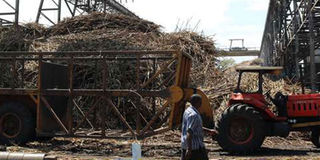An experiment that went wrong

Sugarcane is offloaded from a tractor at Chemelil Sugar Factory in Kisumu County on September 12, 2016. Chemelil was the first experiment on smallholder sugar production in Kenya. PHOTO | TONNY OMONDI | NATION MEDIA GROUP
What you need to know:
- In July 1972, the government made a decision to form the giant Mumias Outgrowers Company (Moco) owned by it, outgrowers, and Mumias Sugar Company.
- Its work, like the Kenya Tea Development Authority, was to offer farmers inputs at subsidised rates and organise cane planting and harvesting.
Chemelil was the first experiment on smallholder sugar production in Kenya, starting operations in 1965.
Records show that after only six years, officials knew it was a flop.
The proposed sugar cooperatives had failed, triggering a war of words between Cabinet ministers Jeremiah Nyagah and Masinde Muliro in 1971 — at about the time Mumias was being mooted.
Cooperatives that were to be used in the production chain were abandoned, resulting in chaos.
Institutions set up as the link between farmers and millers collapsed.
In July 1972, the government made a decision to form the giant Mumias Outgrowers Company (Moco) owned by it, outgrowers, and Mumias Sugar Company.
Moco collapsed in 2008, leaving farmers with no voice at the factory level.
What is not known is that Moco’s collapse was a result of a bitter war between the Cooperatives and Agriculture ministries on the kind of institution required for the sector.
“Moco was a great way of communicating with farmers. For me it was easy to pick up the phone and call the chairman and say, come and have a meeting with me because we have this and that problem. Now, if there is a problem, who do I call?” asks Mumias chief executive Errol Johnston.
Its work, like the Kenya Tea Development Authority, was to offer farmers inputs at subsidised rates and organise cane planting and harvesting.
POOR PRODUCTION
Today, this lack of organisation has left sugar factories grappling with problems of lack of cane and spoilt or overgrown cane.
For instance, Muhoroni, now in receivership, receives 90 per cent of its cane from smallholder farmers who are always grappling with transport problems, overgrown and poor quality cane.
This is the same story at Mumias, Chemelil, Sony, Nzoia and Miwani, which is also in receivership.
In 2014, these five factories produced 321,000 tonnes compared with Malawi’s sole producer Illovo Sugar, formerly owned by Lonrho, whose two factories produced 289,000 tonnes.
Zambia’s single factory produced 450,000 tonnes while Kenya’s 11 factories produced 592,668 tonnes last year.
These figures are a good indicator of the economics of sugar production and how they favour larger farms.
It now appears that this chaotic situation was foreseen as far back as 1971, even before farmers were enticed to grow cane.
“Without collective discipline, the cane supply will be sporadic — either too little, resulting in idle time at the mill and, therefore, high production costs, or too much (where) the mill will not be able to handle it, (leading to) cane spoils, high costs and recurring losses,” warned sugar farming consultant, B C J Warnes.
Reported by Gerald Andae, Edwin Okoth and John Kamau



